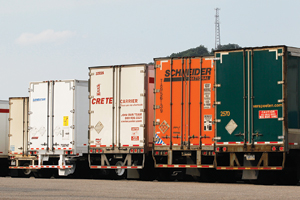Senior Reporter
NHTSA Issues Proposed Rule to Upgrade Rear Impact Guard Standard

The National Highway Traffic Safety Administration on Dec. 7 issued a proposed rule to upgrade current rear impact guards on trucks and trailers to address underride protection in car crashes into trailers and semitrailers.
The proposal adopts requirements of Transport Canada’s standard for underride guards, which require rear impact guards to provide sufficient strength and energy absorption to protect occupants of compact and subcompact passenger cars striking the rear of trailers at 56 kilometers per hour, or 35 mph.
The proposed rule follows an advance notice of proposed rulemaking on rear underride crash protection and visibility conspicuity of single-unit trucks issued earlier this year.
“Robust trailer rear-impact guards can significantly reduce the risk of death or injury to vehicle occupants in the event of a crash into the rear of a trailer or semitrailer,” NHTSA Administrator Mark Rosekind said in a statement. “We’re always looking at ways to safeguard the motoring public, and today’s announcement moves us forward in our mission.”
The agency said it would accept comments on the NPRM for 60 days.
The annual average incremental material and fuel cost of requiring all applicable new trailers in the fleet with the upgraded guards would be $13 million, according to NHTSA.
The agency said it issued the notice of proposed rulemaking in response to a petition from the Insurance Institute for Highway Safety, Marianne Karth and the Truck Safety Coalition.
In excessive underride crashes, there is passenger compartment intrusion as the passenger vehicle underrides so far that the rear end of the struck vehicle enters the passenger compartment of the striking passenger vehicle, NHTSA said.
“PCI can result in severe injuries and fatalities to occupants contacting the rear end of the struck vehicle,” the proposal said. “A rear-impact guard prevents PCI when it engages the smaller striking vehicle and stops the vehicle from sliding too far under the struck vehicle’s bed and chassis.”
The agency said safety features built into today’s passenger vehicles are able to provide high levels of occupant protection in 35 mph frontal crashes. This NPRM would require trailer and semitrailer guards to remain in place and prevent PCI in crashes of severities of up to 35 mph versus the current requirement of up to 30 mph.
In 2009, NHTSA said it reviewed cases of frontal crash fatalities to belted drivers and/or right-front passengers in model year 2000 or newer vehicles in the Crashworthiness Data System of the National Automotive Sampling System through calendar year 2007.
“Among the 122 fatalities examined in this review, 49 [40%] were in exceedingly severe crashes that were not survivable, 29 [24%] were in oblique or corner impact crashes where there was low engagement of the striking vehicle’s structural members [a factor which would have resulted in the striking vehicle absorbing more of the crash energy] and 17 [14%] were underrides into single-unit trucks and trailers [14 were rear underride and three were side underride],” the NHTSA proposal said.
Full Proposed NHTSA Rule Below

